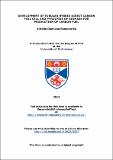Files in this item
Development of tubular hybrid direct carbon fuel cell and pyrolysis of biomass for production of carbon fuel
Item metadata
| dc.contributor.advisor | Irvine, John T. S. | |
| dc.contributor.author | Bonaccorso, Alfredo Damiano | |
| dc.coverage.spatial | ix, 282 | en_US |
| dc.date.accessioned | 2013-06-04T08:28:55Z | |
| dc.date.available | 2013-06-04T08:28:55Z | |
| dc.date.issued | 2013 | |
| dc.identifier | uk.bl.ethos.574813 | |
| dc.identifier.uri | https://hdl.handle.net/10023/3597 | |
| dc.description.abstract | This study involved two avenues of investigation: a new concept of Direct Carbon Fuel Cell (DCFC) and the production of carbon from biomass. The new concept of DCFC merges a solid oxide electrolyte and a molten carbonate electrolyte called the “hybrid direct carbon fuel cell” using tubular geometry. The tubular cell was chosen for several reasons, such as sealing process, reduction of stress during the sintering process and reduction of the final size of the stack. In addition, it makes the fuelling process easier than in planar geometry. The previous tests carried out on tubular hybrid direct carbon fuel cell at the University of St Andrews showed promising results. In fact, a power of 85 mW was achieved at 800ºC. However this temperature was too high and so the focus of the new project was on decreasing the operating temperature to 650ºC, replacing the YSZ electrolyte used in the previous configuration with an electrolyte such as GDC, which showed better performance at low temperature. YSZ was substituted for GDC in the anodes and cathode in order to prevent an increase in the interface resistance due to the possible reaction between electrolyte and electrodes at the interface. Anodes with different proportions of NiO and GDC were investigated in order to understand the electrochemical phenomena in the presence of GDC compared to YSZ. Three different electrical configurations were investigated by AC impedance studies because the electrochemistry of the cell changes as function of the position and the surface of the current collector, which is dipped into the anode chamber. Performance improved when the surface area of the current collector increased, which combined a silver wire with strip of nickel mesh. Two types of seals (552 ceramabond and ToKu adhesive) and the sealing process were also studied in order to prevent leakage, which affects the performance of the entire cell. The leakages were reduced using a composite seal composed of alumina paste and a combination of flexi disks of mica and alumina fibre disk. In the preliminary test using 70-30%wt NiO GDC and LSM-GDC with composite nickel mesh and silver wire current collector and the composite seal, a promising value of power of 191mW was achieved at 700ºC using GDC electrolyte. The value of power was improved by reducing the thickness of the electrolyte and the cathode manufacture. However, the best performance was achieved when LSM-GDC cathode was replaced with LSCF- GDC. LSCF was chosen for the promising results shown at low temperature, and a power of 240mW was achieved at 650ºC when it was used as the cathode in our cell. The carbon fuel used for these fuels was a medium density fibreboard pyrolysed at 500°C. The choice of this carbon fuel was based on the production and characterization of carbon fuels in this project. The investigations were focused on the production and characterization of carbon fuel from biomass such as MDF and pellet wood produced by pyrolysis. Secondary products resulting from the pyrolysis process were also investigated in order to use them as alternative fuels. All of the types of carbons produced and 3 commercial carbons were characterized by SEM, XRD, infrared spectroscopy, surface area and elemental analysis, while their electrochemical performances were investigated by hybrid direct carbon fuel cell with planar geometry. The investigations highlight that the structure of the carbon used does not affect the performance of the cell, which is in fact affected by the ability of the carbon to gasify in the presence of carbonate. | en_US |
| dc.language.iso | en | en_US |
| dc.publisher | University of St Andrews | |
| dc.subject.lcc | TK2931.B76 | |
| dc.subject.lcsh | Fuel cells--Materials | en_US |
| dc.subject.lcsh | Fuel cells--Testing | en_US |
| dc.subject.lcsh | Biomass conversion--Testing | en_US |
| dc.title | Development of tubular hybrid direct carbon fuel cell and pyrolysis of biomass for production of carbon fuel | en_US |
| dc.type | Thesis | en_US |
| dc.type.qualificationlevel | Doctoral | en_US |
| dc.type.qualificationname | PhD Doctor of Philosophy | en_US |
| dc.publisher.institution | The University of St Andrews | en_US |
This item appears in the following Collection(s)
Items in the St Andrews Research Repository are protected by copyright, with all rights reserved, unless otherwise indicated.

